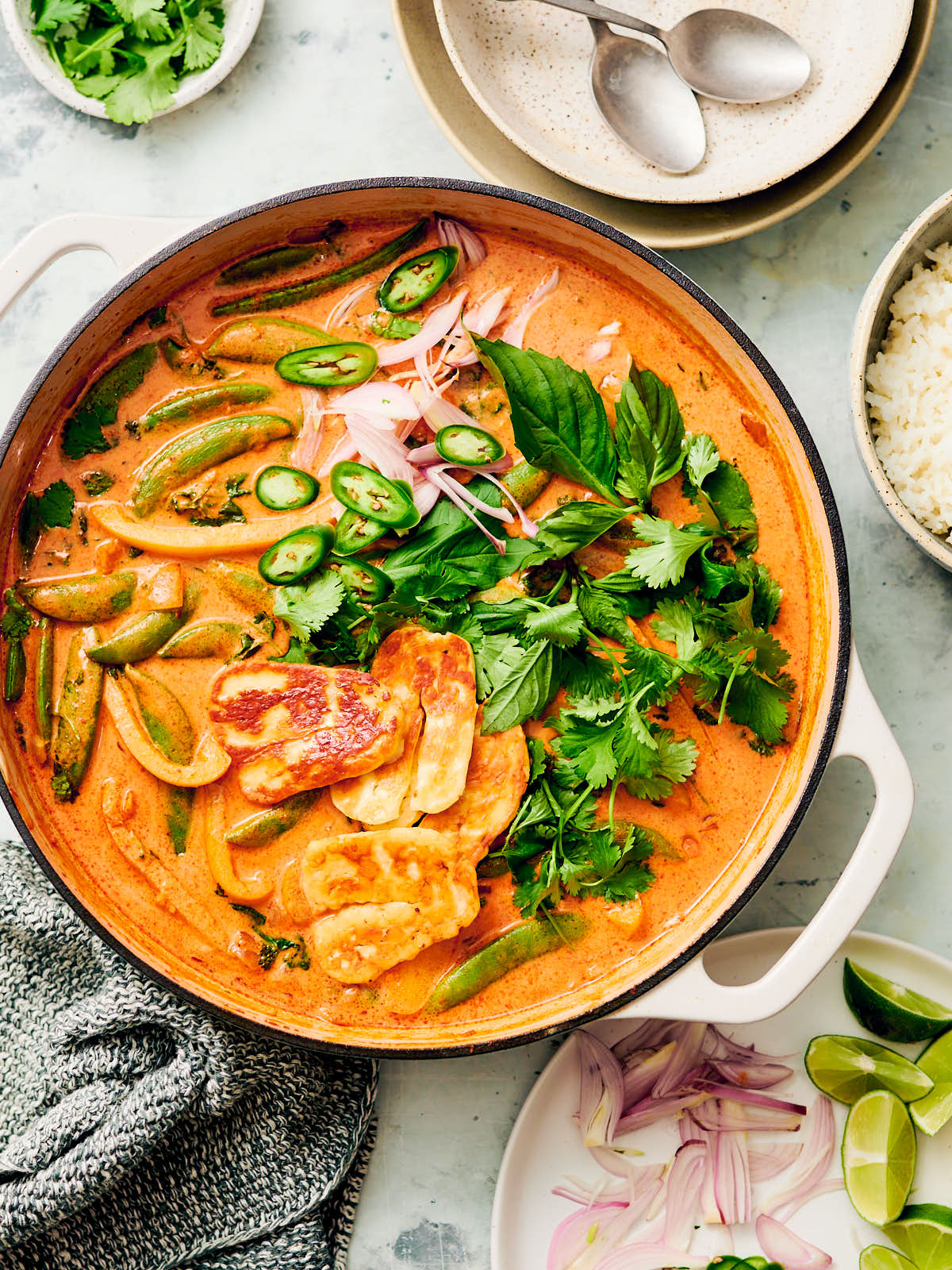
Thai-inspired Halloumi Curry is certainly not traditional, but the flavors are undeniably delicious. While we love tofu in many forms (including crispy, saucy, dippable), we recognize that not everyone does. Enter, halloumi cheese. Seared halloumi cheese is crispy, salty, and dare we say...almost meaty. It's a satisfying and crowd-pleasing addition to this creamy Thai red coconut curry.
This dish is easy enough to throw together on a weeknight. And, impressive enough to serve to friends. Feel free to swap in whatever veggies you have in the fridge. Scattering fresh herbs on top is optional, but makes an extra pretty finish.
Jump to:
Why you'll love this recipe
- Fast to make: This Halloumi Curry recipe takes 30 minutes or less. So, it's a quick homemade dinner that can be on the table faster than ordering delivery!
- Vegetarian and tofu-free: Vegetarian Thai curry dishes are often made with tofu. However, this recipe uses halloumi cheese as a crowd-pleasing swap. Halloumi cheese is delicious, salty, and seared until crispy. Definitely not traditional, but definitely delicious!
- Adaptable: Have different vegetables laying around in the fridge? Feel free to use them here! Fresh garnishes are optional, but also super flexible based on what you have on hand.

Ingredients (and substitutes)
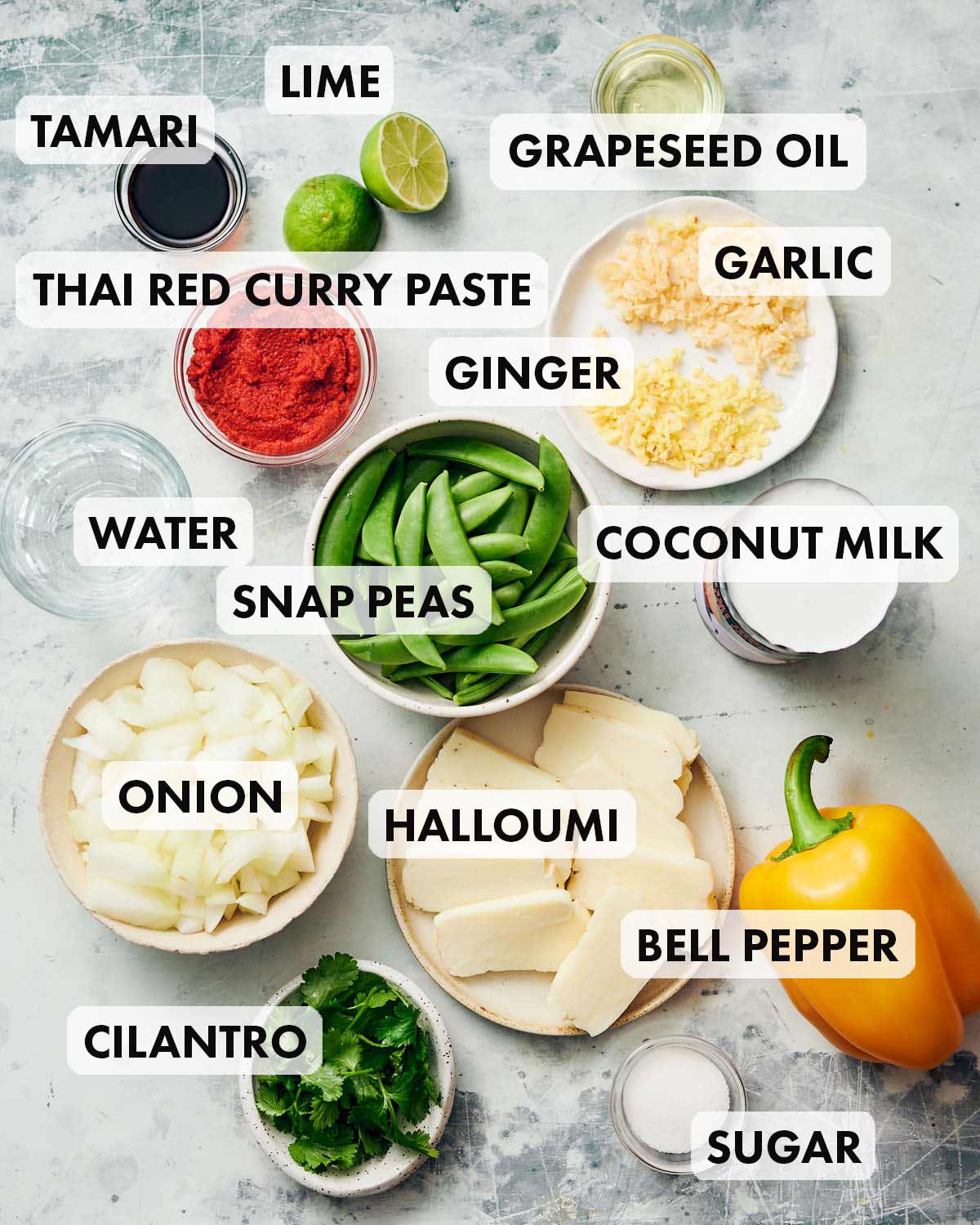
- Halloumi Cheese: Halloumi cheese has a high melting point, so you can pan-fry it until it's golden brown and crispy. It's ridiculously delicious. Buy a block of halloumi cheese that isn't pre-seasoned with extra spices and herbs.
- Thai Red Curry Paste: Curry paste is a speedy flavor shortcut here! Keep in mind, curry pastes vary significantly by brand. So, if you're using a new-to-you brand, start on the lower end of the range and add more as needed. The recipe gives you a range, but use your tastebuds as the ultimate guide.
- Coconut Milk: We always recommend full-fat coconut milk, for the best flavor and value at the grocery store. (Light coconut milk is a watered down version, sold for the same price!).
- Snap Peas: We love to toss in a bag of crisp snap peas for extra veggies. Snap peas keep for a while in the fridge and don't require chopping. But, you could easily substitute another sturdy vegetable instead, such as broccolini, broccoli, carrots, or an extra bell pepper.
Want more Thai-inspired recipes? Make Thai Green Curry Fried Rice, Vegan Tom Yum Soup, Spaghetti Squash Pad Thai, Vegan Pad Thai Sauce, or Thai Hot and Sour Soup.

How to make (step-by-step photos)
This Halloumi Curry is easy to make! Here are the steps to making this recipe:
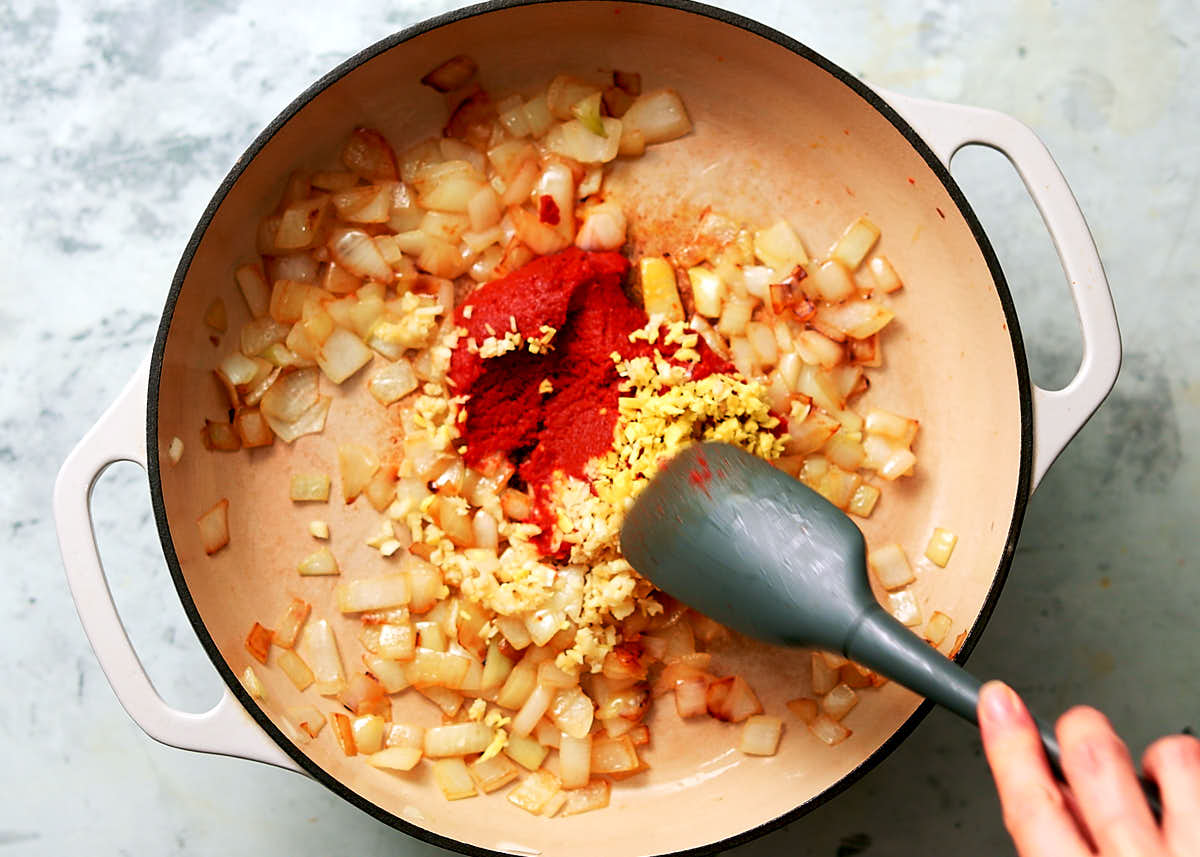
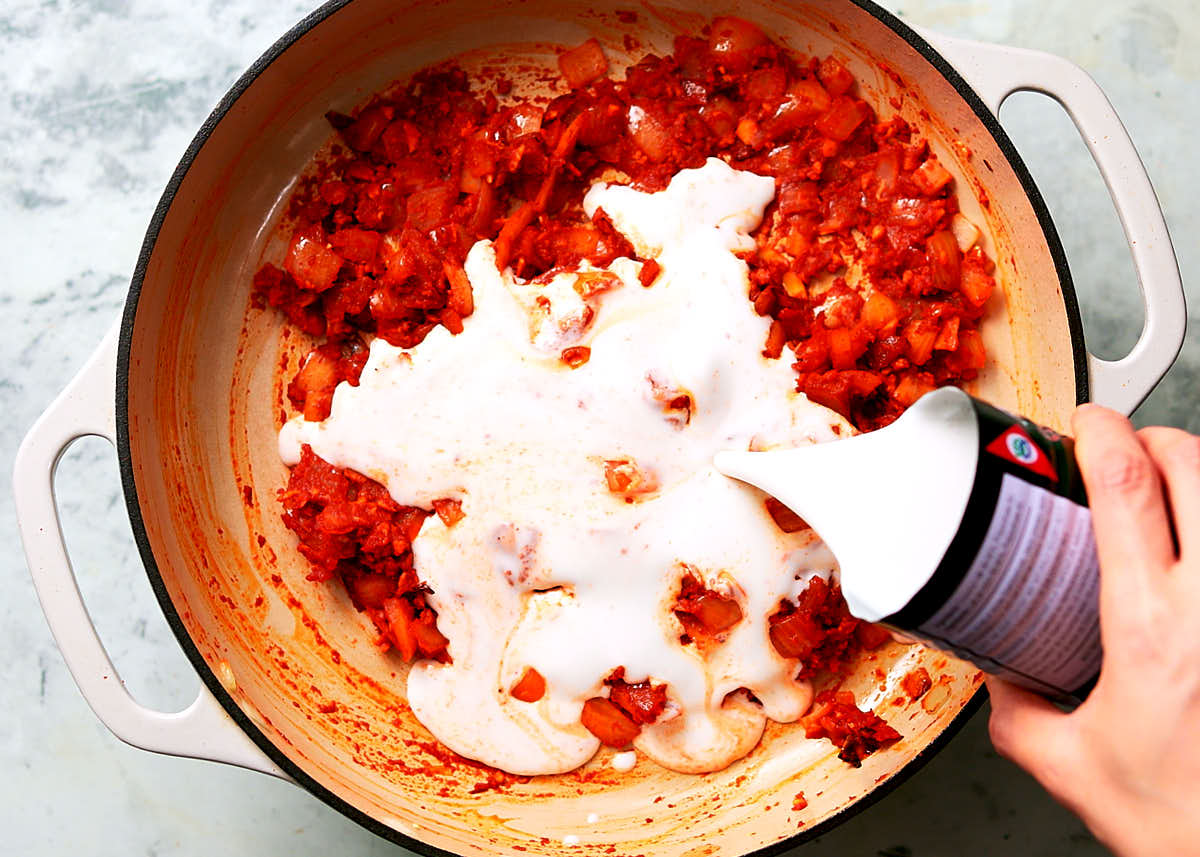
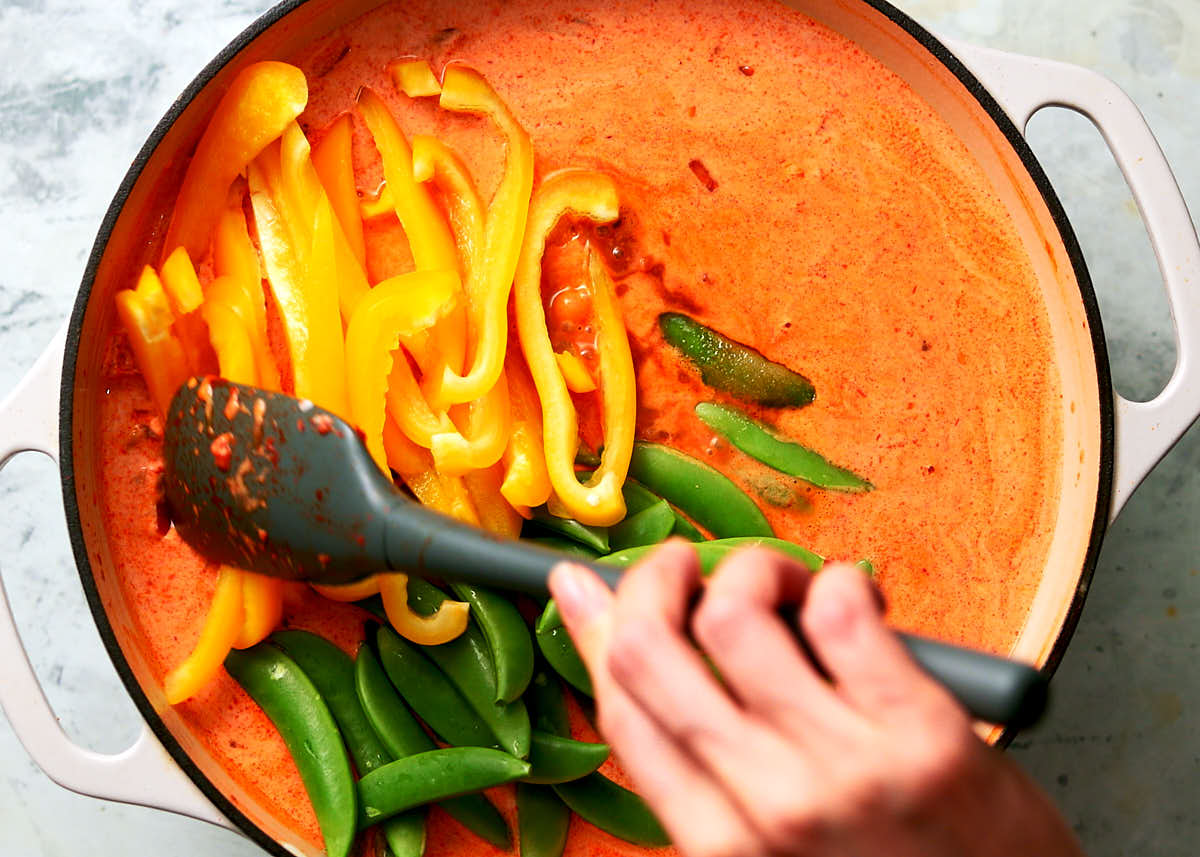
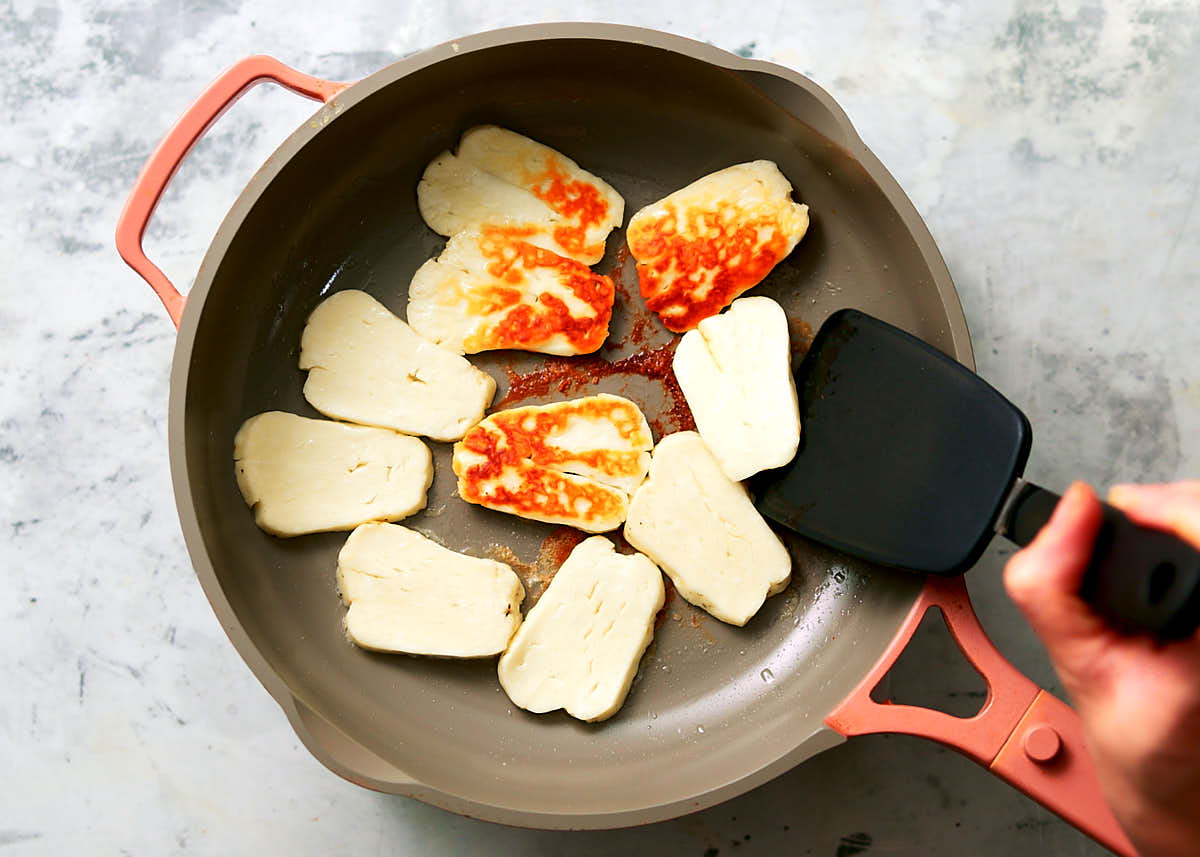
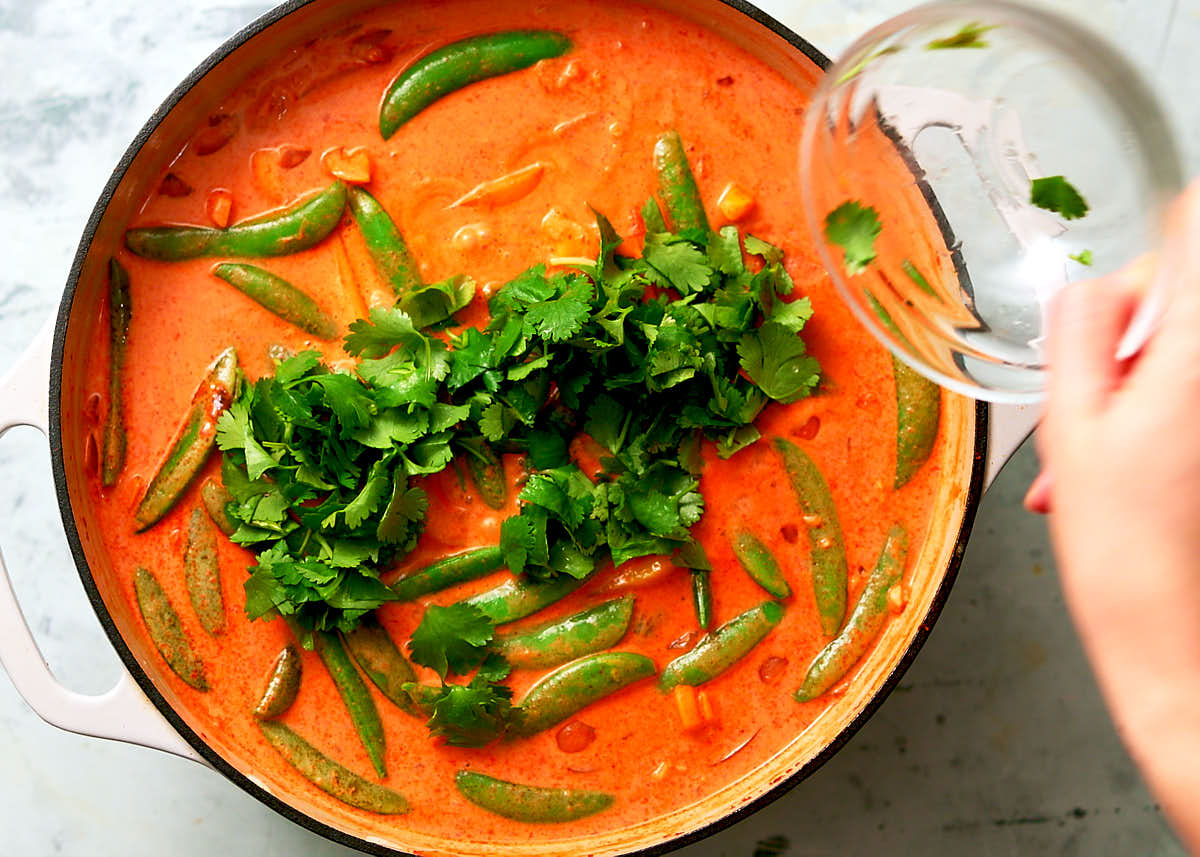
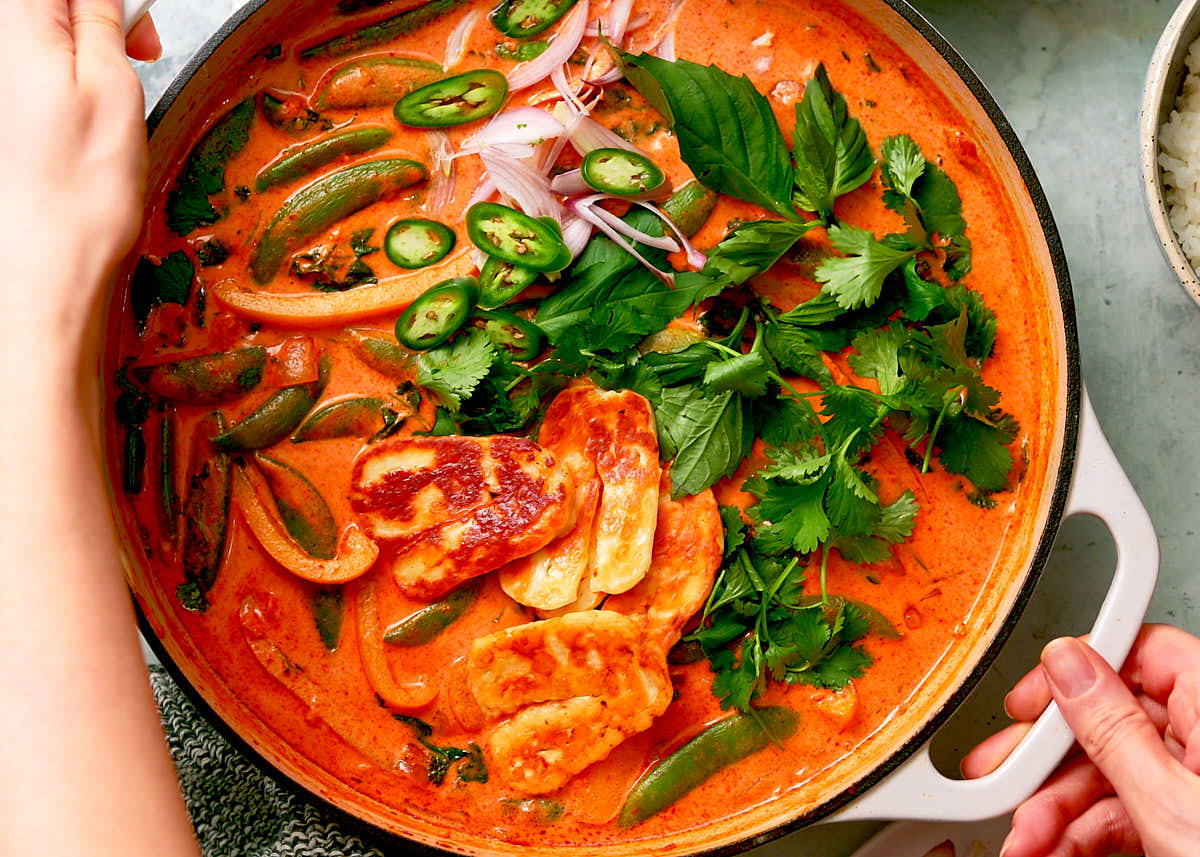
Find the recipe card below for the complete recipe, including all ingredients and instructions.
Check out these one pot dinner recipes: One Pot Tomato Harissa Orzo, Creamy Vegetarian Tortellini Soup, One Pan Lemon Spinach Orzo, Vegan Red Lentil Soup.
Recipe video

Frequently asked questions
Thai curry paste is a mixture of pulverized aromatics, herbs, and spices (source). There are many different types of Thai curry pastes—but the red variety typically uses red chili, garlic, lemongrass, shallot, galangal, lime zest, and salt. The exact ingredients and proportions vary by brand.
Shrimp paste may also be added. However, there are vegetarian versions of Thai red curry paste that don't use it.
Brands vary significantly in their flavor, spice, and saltiness. As a result, people may have different preferences when it comes to the "best" Thai red curry paste.
Brands like Maesri and Aroy-D are generally more intense and flavorful, compared to Thai Kitchen red curry paste. All three of these brands are vegetarian / vegan. Mae Ploy is another popular brand of Thai curry paste, but the red curry paste contains shrimp so it is not vegetarian. It's flavor/intensity would be similar to Maesri and Aroy-D.
This recipe isn't nearly as spicy as it may look. If made with a mild curry paste, like Thai Kitchen, the final curry is not very spicy at all. Of course, you can increase the spice by using a more intense curry paste (see brands above), using more curry paste, or by adding fresh sliced chili as a garnish.
Yes, you can definitely make this recipe in advance! The curry keeps well in the fridge. We recommend storing the curry separately from the rice.
For full transparency, Halloumi cheese is best served when it's hot and crispy. So, if you can, we recommend pan frying it fresh. (But, it'll still be tasty the next day if you can't!).
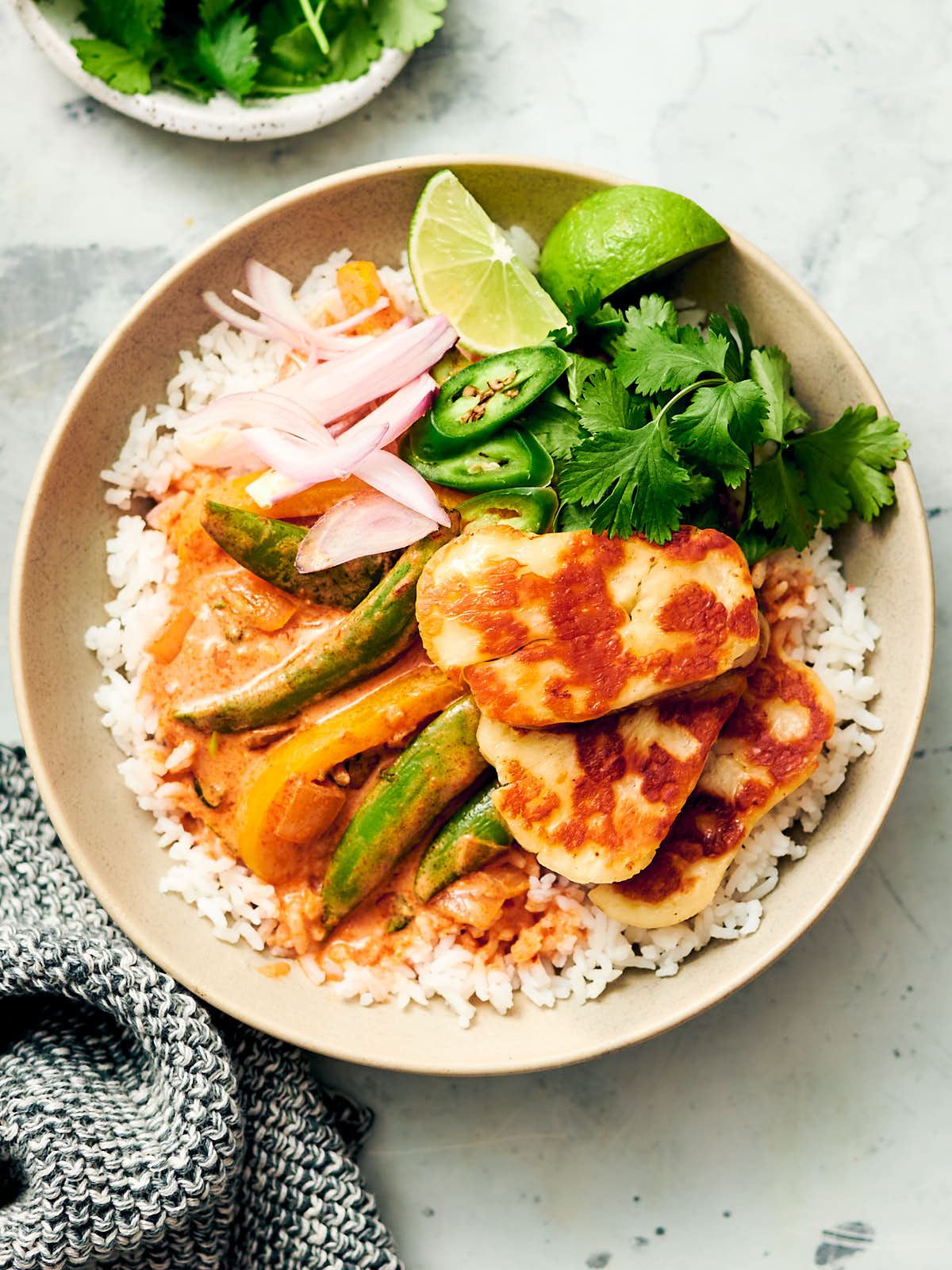
Love this recipe? Please leave a 5-star 🌟🌟🌟🌟🌟 review below!
📖 Recipe
Easy Halloumi Curry
Ingredients
- 2½ tablespoons grapeseed oil, divided
- 1 medium yellow onion, diced (1½ cups)
- 4 to 6 tablespoons Thai red curry paste (see note 1)
- 4 cloves garlic, minced
- 1 tablespoon minced ginger
- 1 (14 fl oz / 398 ml) can full-fat coconut milk
- ½ cup water
- 8 oz sugar snap peas
- 1 yellow bell pepper, thinly sliced (or red or orange)
- 1 tablespoon tamari (or soy sauce)
- 1 tablespoon sugar (see note 2)
- 8.8 oz Halloumi cheese, sliced (¼-inch/0.5 cm thick)
- 1 tablespoon fresh lime juice
- ½ cup chopped cilantro (packed)
- Rice and garnishes (optional), for serving (see note 3)
Instructions
- Cook aromatics: In a large skillet, heat 1 tablespoon of grapeseed oil over medium heat. Add onion and cook until golden-brown around the edges, about 5 minutes. Add another 1 tablespoon of grapeseed oil, 4 tablespoons of curry paste (see note 1), garlic, and ginger. Cook, stirring constantly, for 1 minute.
- Simmer curry: Pour in the coconut milk and water. Stir to mix. Let gently simmer for 10 minutes for the flavors to meld.
- Add veggies: Taste curry after simmering and add more curry paste to taste (for milder curry pastes, you'll likely need to add 1 to 2 tablespoons). Add snap peas, bell pepper, tamari and sugar. Cook until veggies are tender, about 3 minutes.
- Sear halloumi: Meanwhile, in a non-stick frying pan, heat the remaining ½ tablespoon (or 1½ teaspoons) grapeseed oil over medium-high heat. Once hot, spread halloumi slices in a single layer and cook until golden brown, about 1 to 2 minutes per side.
- Finish curry and assemble: Remove from heat. Stir in lime juice and cilantro. Taste and adjust seasonings if needed. Top the curry with the seared halloumi cheese and fresh garnishes (see note 3), if using. Spoon over rice.
Notes
- Thai red curry paste: Brands vary significantly in their flavor, spice, and saltiness. This recipe recommends a range—start on the lower end and add more if needed (to suit your tastes). If using curry paste from a brand like Maesri or Aroy-D, you'll likely need the lower end of the range. Thai Kitchen is very mild, so plan to use the upper end of the range (i.e. almost the full jar for one batch of this recipe). If you're vegetarian or vegan, read the label because some brands add shrimp paste.
- Sugar: A small bit of sugar helps balance out the flavors. You can use cane sugar, granulated sugar, or coconut sugar.
- Garnish ideas: Fresh herbs (such as: cilantro, Thai basil, scallions/green onions), Shallots, Lime wedges, Chili peppers (such as: serrano, jalapeno, or fresno) would all be great options for serving with this curry.
- Storage and reheating tips: We recommend refrigerating extra curry separately from the rice. (Otherwise, the rice will absorb the curry as it sits). Halloumi is best served when freshly seared and hot, but you can also store it in the fridge to enjoy the next day.

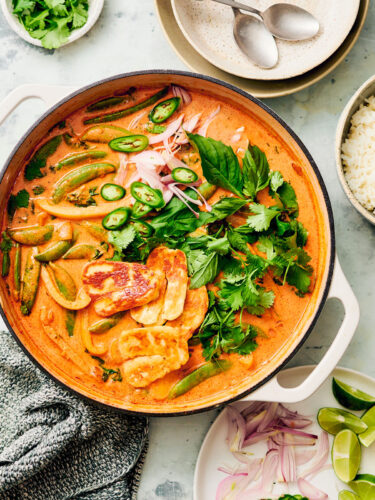
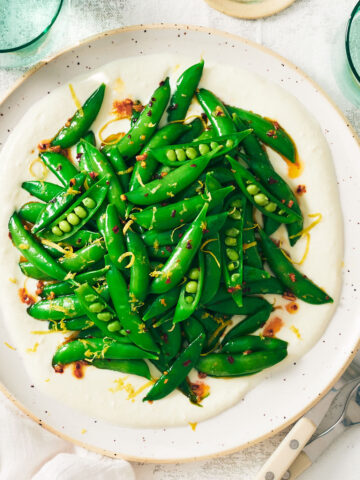
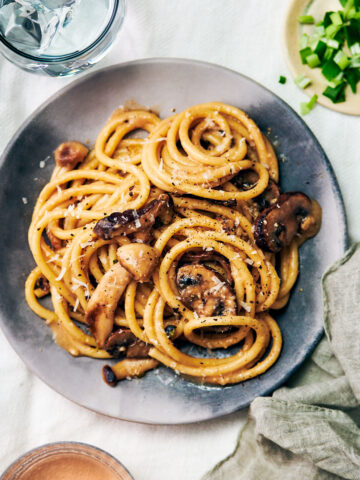
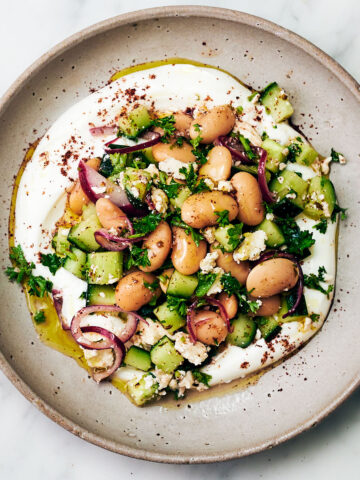

Sam H says
Loved this combo! Very good.
bri says
Hi Sam! So happy to hear you loved this recipe. Thanks for sharing!
Kathy says
Yummy! I made this with Thai Kitchen red curry paste because that's all my grocery store carries. I ended up using 6 tbsp of paste but could have easily used the whole jar. Served it with long grain brown rice. Added green onions and cilantro on top. Fam ate it up.
bri says
Hi Kathy! So glad to hear you enjoyed this recipe. Thanks so much for sharing